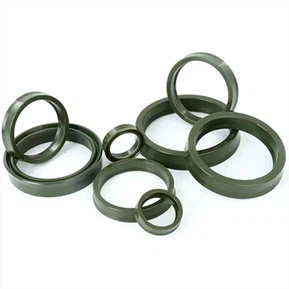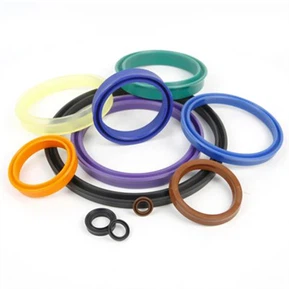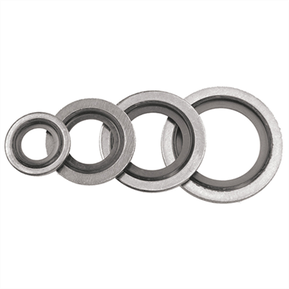What Is an O-Ring?
An O-ring is a small, circular sealing component with a round cross-section (resembling the letter “O”), typically made of elastic materials like rubber or polymers. Its primary role is to create a leak-proof seal between two or more mating components, preventing the escape of fluids (liquids or gases) or the entry of external contaminants (e.g., dust, moisture) into a system. It is one of the most widely used sealing solutions across industries due to its simplicity, cost-effectiveness, and reliability.
1. Core Function: Sealing and Containment
The O-ring’s main purpose is to solve “leakage problems” in mechanical systems. Here’s how it works:
- When installed between two components (e.g., a lid and a container, or two pipes), the O-ring is compressed by the mating surfaces.
- Its elastic material deforms to fill tiny gaps (even microscopically small ones) between the components, forming a tight, continuous barrier.
- This barrier blocks two unwanted outcomes:
-
- Internal leakage: Prevents fluids/gases inside the system from escaping (e.g., stopping oxygen from leaking out of a portable oxygen generator).
-
- External intrusion: Stops outside substances (e.g., dust, water) from entering the system, which could damage internal parts or contaminate the medium (e.g., pure oxygen).
2. Key Factors That Make O-Rings Effective
For an O-ring to work well, three factors are critical:
- Elasticity: Materials like rubber or silicone can stretch and compress repeatedly without losing shape—ensuring long-term sealing.
- Compatibility: The O-ring material must not react with the fluid/gas it contacts (e.g., oxygen-compatible materials avoid combustion risks in oxygen systems).
- Compression Ratio: Proper compression (typically 10–30% of the O-ring’s cross-sectional diameter) ensures a tight seal without damaging the material.
3. Common Materials for O-Rings
O-rings are made from different materials to suit specific environments. Here are the most widely used types, including those relevant to oxygen equipment:
|
Material
|
Key Properties
|
Typical Applications
|
|
Silicone Rubber
|
Resists high/low temperatures (-60°C to 230°C), non-toxic, compatible with oxygen.
|
Medical devices (oxygen generators, syringes), food processing.
|
|
Nitrile Rubber (NBR)
|
Good resistance to oils, fuels, and water; low cost.
|
Automotive engines (oil seals), hydraulic systems.
|
|
Fluororubber (FKM)
|
Excellent high-temperature (up to 260°C) and chemical resistance.
|
Aerospace (jet fuel systems), industrial ovens.
|
|
Ethylene-Propylene (EPDM)
|
Resists water, steam, and weathering; low cost.
|
Plumbing (pipe joints), HVAC systems.
|
Note for oxygen equipment: Silicone or fluororubber O-rings are preferred because they do not react with high-pressure oxygen (unlike some rubbers that may ignite) and maintain elasticity in the temperature ranges of oxygen generators.
4. Critical Applications—Including Oxygen-Related Equipment
O-rings are used in nearly every industry, but their role is especially vital in systems where leaks could be dangerous or reduce efficiency. Below are key uses, with a focus on the oxygen devices you’ve explored:
a. Portable Oxygen Generators (POCs) & Oxygen Concentrators
- Sealing key components: O-rings seal the connections between the POC’s compressor, sieve bed (which filters nitrogen), and oxygen outlet. This prevents oxygen from leaking out (ensuring the device delivers the required flow rate) and stops ambient air from entering (which would dilute the oxygen purity).
- Air intake filters: O-rings around the air filter housing keep dust and debris out of the POC’s internal parts (e.g., compressors), preventing damage and maintaining performance.
b. Oxygen Tanks/Cylinders
- Valve seals: O-rings are used in the valves of high-pressure oxygen tanks to prevent catastrophic leaks. Since oxygen is highly flammable under pressure, a intact O-ring is critical for safety.
c. Other Major Applications
- Automotive: Seal engine oil pans, fuel injectors, and cooling systems to prevent fluid leaks.
- Aerospace: Seal fuel lines, hydraulic systems, and cabin pressure controls in aircraft.
- Medical: Seal syringes, dialysis machines, and anesthesia equipment to prevent contamination or fluid loss.
- Plumbing & Industrial: Seal pipe joints, pumps, and tanks to stop water, chemicals, or gases from leaking.
5. Maintenance: When to Replace O-Rings
O-rings are wearable parts and need replacement over time. Signs that an O-ring has failed or needs changing include:
- Visible damage: Cracks, tears, hardening (loss of elasticity), or swelling (from reacting with the fluid/gas).
- Leakage: Hissing sounds (in gas systems like oxygen generators), reduced pressure, or visible fluid stains around the sealed area.
- Aging: Even without visible damage, O-rings degrade over time (especially in extreme temperatures or harsh chemicals) and should be replaced per manufacturer guidelines (e.g., every 1–2 years for oxygen equipment).
Important for oxygen systems: Always replace O-rings with oxygen-compatible materials (e.g., silicone) and avoid oil-based lubricants (which can ignite in high-pressure oxygen). Use only oxygen-specific lubricants (e.g., silicone grease) if needed.
Conclusion
O-rings are simple but indispensable components that ensure the safety, efficiency, and reliability of countless systems—from portable oxygen generators to aerospace engines. Their core job (sealing against leaks) is especially critical in oxygen equipment, where even small leaks can reduce oxygen purity or create safety hazards. By choosing the right material and maintaining them properly, O-rings help keep devices running smoothly for years.




